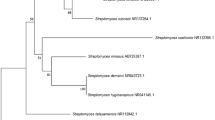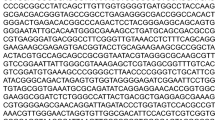Abstract
An actinomycete strain KN-0647 was isolated from a forest soil sample collected from Dali Cangshan mountain, Yunnan Province, China. The strain was identified as Streptomyces sp. according to the morphological, physiological characteristics and whole nucleotide sequence analysis of 16S rRNA gene, and could not be identified up to species level, just suggesting a potential new taxon. The ethyl acetate extract from this strain displayed growth inhibition on the test pathogenetic insects, such as Spodoptera exigua, Dendrolimus punctatus, Plutella xylostella, Aphis glycines and Culex pipiens. The active compound was isolated and identified through a combination of spectral and chemical methods (UR, MS, and 1HNMR) as quinomycin A. This is the first report on the insecticidal activity of antibiotic quinomycin A.



Similar content being viewed by others
References
Arai T (1976) Actinomycetes; The Boundary Microorganisms. Toppan, Singapore
Felsenstein J (1985) Confidence limits on phylogenies: an approach using the bootstrap. Evolution 39:783–789
Hasegawa T, Takizawa M, Tanida S (1983) A rapid analysis for chemical grouping of aerobic actinomycetes. J Gen Appl Microbiol 29:319–322
Kelly KL (1964) Inter-society color council—National bureau of standards color name charts illustrated with centroid colors. Washington, DC: US Government Printing Office
Kimura M (1980) A simple method for estimating evolutionary rates of base substitutions through comparative studies of nucleotide sequence. J Mol Evol 16:111–120
Kumar S, Tamura K, Nei M (2004) MEGA3: integrated software for molecular evolutionary genetics analysis and sequence alignment. Brief Bioinform 5:150–163
Li GK, Zhang Q, Jiang Y, Zhu BQ, Hu HF (2004) Studies on compounds SIPI-1140A and B with inhibitory activity against antibiotic-resistant microbes from microorganisms . Chin J Nat Med 12 (3):189–192
Li WJ, Xu P, Schumann P, Zhang YQ, Pukall R, Xu LH, Stackebrandt E, Jiang CL (2007) Georgenia ruanii sp. nov., a novel actinobacterium isolated from forest soil in Yunnan (China) and emended description of the genus Georgenia. Int J Syst Evol Microbiol 57:1424–1428
Locci R (1989) Streptomyces and related genera. In: Williams ST, Sharpe ME, Holt JG (eds) Bergey’s manual of systematic bacteriology, vol 4. Williams & Wilkins Co, Baltimore, pp 2463–2468
Martin DG, Mizsak SA, Biles C (1975) Structure of quinomycin antibiotics. J Antibiot 28 (4):332–339
NIAID (2001) NIAID Global Health Research Plan for HIV/AIDS, Malaria and Tuberculosis US, Department of Health and Human Services, Bethesda, MD
Pridham TG, Lyons AJ (1980) Methodologies for Actinomycetales with special reference to streptomycetes and streptoverticillia. In Dietz A, Thayer DW (eds) Actinomycete Taxonomy, Special publication no 6. Arlington, VA: Society for Industrial Microbiology, pp 153–224
Saitou N, Nei M (1987) The neighbor-joining method: a new method for reconstructing phylogenetic tree. Mol Biol Evol 4:406–425
Searle MS (1994) Binding of quinomycin antibiotic UK-65,662 to DNA: 1H-nmr studies of drug-induced changes in DNA conformation in complexes with d (ACGT)2 and d(GACGTC)2. Biochem J 304:967–979
Shi JJ, Qi CQ, Chen WJ (1999) The revision of 1H, 13C-NMR assignments of quinomycin A and C. J Chin Antibiot 24(4):258–262
Shirling EB, Gottlieb D (1966) Methods for characterization of Streptomyces species. Int J Syst Bacteriol 16:313–340
Siddiqui BS, Afshan F, Ghiasuddin, Faizi S, Naqvi SNH, Tariq RM (2000) Two insecticidal tetranortriterpenoids from Azadirachta indica. Phytochemistry 53:371–376
Thompson JD, Gibson TJ, Plewniak F, Jeanmougin F, Higgins DG (1997) The Clustal X windows interface: flexible strategies for multiple sequence alignment aided by quality analysis tools. Nucleic Acids Res 25:4876–4882
Ward D, Reich E, Goldberg IH (1965) Base Specificity in the Interaction of Polynucleotides with Antibiotic Drugs. Science 149:1259–1263
Zin NM, Sarmin NM, Ghadin N, Basri DF, Sidik NK, Hess WM, Strobel GA (2007) Bioactive endophytic streptomycetes fromtheMalay Peninsula. FEMS Microbiol Lett 274:83–88
Acknowledgments
This research was supported by National Significant Basic Project of China (973 2003CB114201 and 2007CB109203). We also thank Dr. Mariko (Meiji Seika Kaisha, Ltd. Agricultural & Veterinary Research Labs Biology Group) for the analysis of chemical structure. W.-J. Li was supported by Program for New Century Excellent Talents in University.
Author information
Authors and Affiliations
Corresponding author
Rights and permissions
About this article
Cite this article
Liu, H., Qin, S., Wang, Y. et al. Insecticidal action of Quinomycin A from Streptomyces sp. KN-0647, isolated from a forest soil. World J Microbiol Biotechnol 24, 2243–2248 (2008). https://doi.org/10.1007/s11274-008-9736-0
Received:
Accepted:
Published:
Issue Date:
DOI: https://doi.org/10.1007/s11274-008-9736-0




